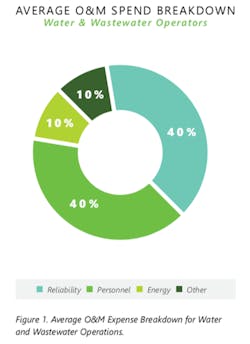Jeff Krimmel is director of market and data analysis for Pinnacle. He has extensive analytical experience in the commercial and market intelligence domains. Before joining Pinnacle, Dr. Krimmel was the director of pricing and market research at Key Energy Services. He has also held various data-driven positions in pricing and profitability, strategic marketing and new product research and development at Baker Hughes. He earned his Ph.D. in mechanical engineering from Caltech, where he used computational approaches to study the use of shockwaves in biomedical applications.
Water processing facilities, whether freshwater or wastewater, are crucial to modern society. They sustain life, protect public health, and lubricate our economic machinery. It is surprising, then, how often we fail to think about these facilities. We expect them to run without failure. On the rare occasion that we lose freshwater or sewage service, we get a harsh reminder of exactly how important the reliability of our water infrastructure is.
Pinnacle, a reliability analytics company, released a report titled “The Global Economics of Reliability Report for US Water & Wastewater Industries”, which analyzed and provided insights into the future of this most valuable commodity.
Definition of Reliability & Its Impact
What is reliability?
In Pinnacle’s analyses, reliability is defined as the measure of how often something runs when you want it to. As we think about the economics of reliability, this draws into consideration how organizations make investments to maintain or improve reliability. In other words, are they being effective in their pursuit of reliability, or not?
The world of water has some important nuances that set it apart from other industrial facilities. Since water and wastewater facilities are almost always built as a part of a development, connected directly to homes or buildings, and owned by local governments, they have no competition. Unlike refineries or chemical plants, water utilities do not have pressure to be profitable to avoid layoffs. They do, however, have a different pressure: to keep water rates low for the citizens they serve.
Reliability’s Impact on U.S. Water Systems
As populations are growing and infrastructure is aging, the quest to maintain affordable water for residents is becoming a more urgent challenge. And since reliability is a requirement, the main question for city managers, utility operators, and other municipal stakeholders is this: How do I spend money in the most effective ways to ensure our water infrastructure, and therefore the supply of water, is reliable?
Historically, much of the strategy in water management has been redundancy. That is, building extra infrastructure to provide extra capacity. That way, if there is a problem with one facility, there is extra capacity to take its place.
One problem with this solution is the cost. It costs more to build, and even more to maintain. Learning lessons from other industries that have been on this journey over the past few decades, water processing facilities are beginning to think differently. They are optimizing the reliability of their infrastructure first to lower operating costs and mitigate the need for new capital.
Report Summary
Pinnacle analyzed operational and financial data from 40 large municipal water and wastewater operators in the U.S. The data came directly from the operators themselves, often via annual reports or budget documents. This data was then used to estimate what the U.S. water and wastewater sector spends annually on reliability-related activities, which include the supplies and labor necessary for repair and maintenance work, along with the engineering work to develop new reliability-enhancing solutions, the cost of sustaining redundant assets, and other similar expenses.
Three Insights & Findings From the Report
Three insights were distilled from Pinnacle’s investigation of its report.
- Water and wastewater operators have a massive opportunity to capitalize on improvements in reliability spending.
- The water and wastewater sectors can apply lessons in other industries and can expect to target similar gains.
- Water and wastewater operators are under-investing in assets today, and prevailing environmental and political dynamics will make it even harder to fill this investment gap in the future.
The report derives three data-driven conclusions.
Disproportionate O&M Spending & Growth Figures for Water Facilities
Operations and maintenance spending levels are growing disproportionately to the amount of water produced and to the spending on other portions of water processing. This is due to a lack of optimization of investment, and as facilities grow older, facilities are simply spending more but getting less out of that spend.
Disparity in Water Facility Reliability Spending
There is a wide disparity in spend level on reliability across facilities. The root causes are difficult to disentangle, given some other large impacts on operations and maintenance (O&M) costs such as proximity to potable water sources. However, by comparing across similarly positioned facilities and overall industry trends, it appears that best-in-class performers spend approximately one third of the amount that industry laggards spend on reliability on a per gallon basis.
Underspending on Short Term Water Infrastructure Projects
In general, operators are under-spending on water infrastructure in the short term. As such, spending on O&M is becoming a larger and larger portion of facility expenses. This appears to be driven by a priority to keep overall costs low and by a slow transition to more optimized operations in some regions.
Reliability Makes a Difference
As the world continues to recover from one of the worst economic downturns in history, more than 85% of the world’s industries are still experiencing difficult markets. With one third of the world’s economy directly affected by the reliability of operations, reliability can make the difference between being an industry leader and laggard.
To download the full report, visit pinnaclereliability.com.


